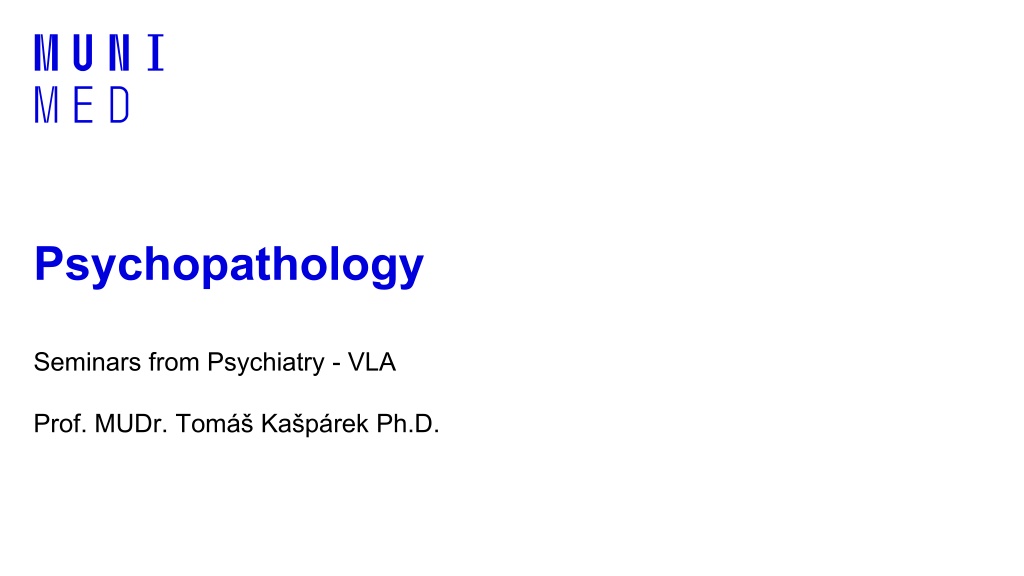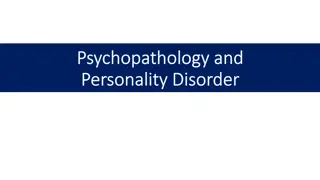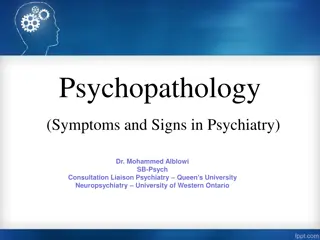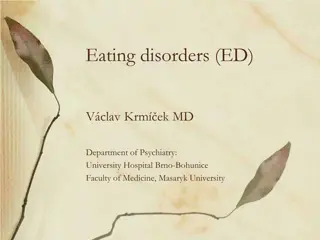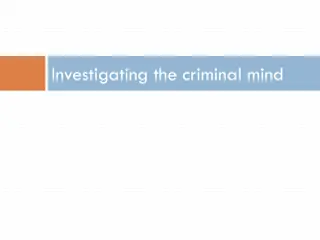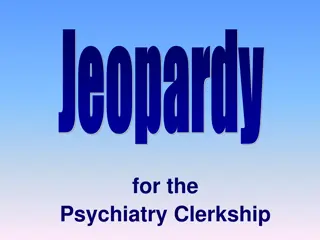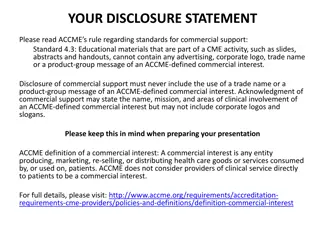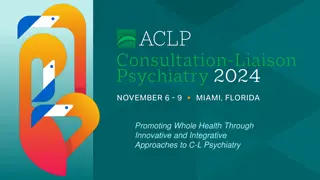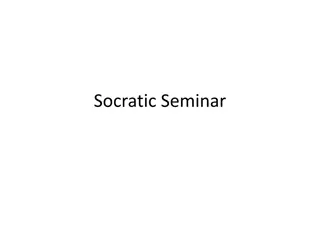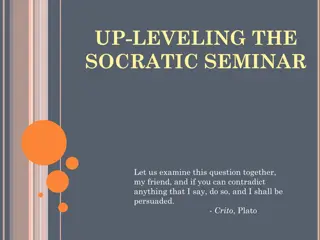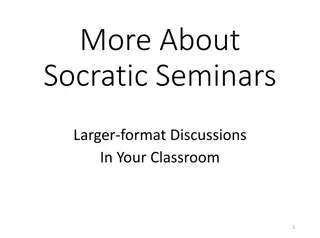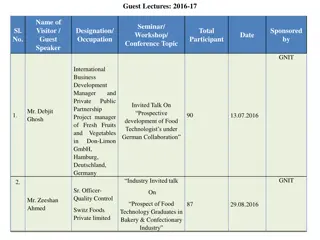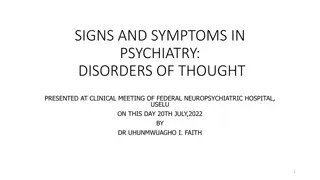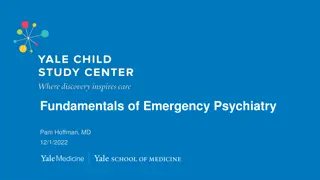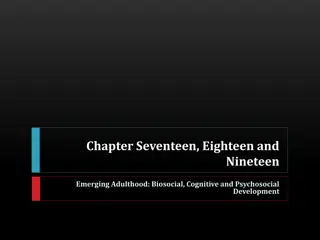Understanding Psychopathology: Insights from Psychiatry Seminars
Delve into the world of psychopathology with insights from Psychiatry Seminars conducted by Prof. MUDr. Tom Kaprek, Ph.D. Explore the domains of psychopathology, learning outcomes, norms vs. pathology, and key concepts related to perception and abnormal autonomy. Gain knowledge on personality, affect, cognition, behavior, and more, enhancing your understanding of mental illness symptoms and psychological functions.
Download Presentation

Please find below an Image/Link to download the presentation.
The content on the website is provided AS IS for your information and personal use only. It may not be sold, licensed, or shared on other websites without obtaining consent from the author. Download presentation by click this link. If you encounter any issues during the download, it is possible that the publisher has removed the file from their server.
E N D
Presentation Transcript
Psychopathology Seminars from Psychiatry - VLA Prof. MUDr. Tom Ka p rek Ph.D.
Outline Introduction why, what, how Domains of psychopathology Prof. MUDr. Tom Ka p rek, Ph.D.
Aim learning outcomes To learn the vocabulary symptoms of mental illness To learn the concepts of discrete psychological functions To learn the description of major and most frequent symptoms Next lecture: how to examine a patient Prof. MUDr. Tom Ka p rek, Ph.D.
Norm and pathology Personal Subjective ego-dystonic experience Significant change in habitual experience and behaviour Does not need to be realised recognized by peers Cultural Conformist and non-conformist behaviour Usual behaviour and experience corresponding to the culture and individual s position within it Non-conformity is not a sign of psychopathology Typical clinical pictures = overt signs of mental illness Hallucinations, catatonia Always search for the reason of behaviour: Why ? Prof. MUDr. Tom Ka p rek, Ph.D.
Domains of psychopathology Personality Affect, emotions Cognition Attention, memory and learning, perception, thinking and decision making Behavior Prof. MUDr. Tom Ka p rek, Ph.D.
Perception Prof. MUDr. Tom Ka p rek, Ph.D.
Perception Illusions - distortions Hallucinations absence of stimuli Sensory modality Auditory: 3rd person perspective, commenting, imperative, contrary Visual: simple (flashes ), complex scenes, microzoopsia Tactile, Gustatory, Olfactory, Movements Intrapsychic hallucinations (see delusions of control) Thought broadcasting, thought imputation/amputation, thought echo s Location/source of hallucinations inadequate (from a teeth, toe ) Prof. MUDr. Tom Ka p rek, Ph.D.
Abnormal autonomy Auditory hallucinations associated with the activation of T-P and F cortex Prof. MUDr. Tom Ka p rek, Ph.D. Hoffman et al., 2007
Abnormal coordination of sensorimotor cortex Corollary discharge: a copy of the motor plan sent to the sensory cortex ( efference copy ) the ensuing perception pattern recognized as resulting from a self- generated action we are not able to tickle ourselves... Absence of the efference copy in the sensory cortex = perception of exogenous origin Schizophrenia: inner voice = hallucinations Prof. MUDr. Tom Ka p rek, Ph.D. Ford et al., 2001; Ford and Mathalon, 2004; 2005
Thought disorders Prof. MUDr. Tom Ka p rek, Ph.D.
Quantitative disturbances: Speed Decrease slowing of the flow of associations, slowed and diminished verbal production (bradypsychism) blocking of thoughts - cessation of the flow of associations ( patient stops the verbal production without any recognisable impulse from surroundings) Increase flight of thoughts: excessive speed of thinking manifested as extreme speed in speech (= logorrhoea) Prof. MUDr. Tom Ka p rek, Ph.D.
Quantitative disturbances: Structure perseverative thinking involuntary persistence of response to some question or topic, verbigeration - a meaningless repetition of specific word or phrase circumstantiality indirect speech that is delayed in a reaching the point, characterised by an overinclusion of details tangentiality patient never gets from desired point to desired goal illogical (paralogical) thinking thinking containing erroneaous conclusions or internal contradiction neologism new word created by the patient often by combining syllables or other words incoherent thinking thought that is not understandable word salad: incoherent mixture of words and phrases Prof. MUDr. Tom Ka p rek, Ph.D.
Impairement of associations/abstract thinking - semanting priming loosenning of associations: tangentiality, paralogic thoughts absence of abstraction - hyperconcretism Semantic priming: automatic (implicit) memory syst m tunes your associations based on current content of mind network of representations (words, meanings) optimal performance = focused activation around the network node Prof. MUDr. Tom Ka p rek, Ph.D.
Lexical decision task DA in cortical networks: SNR ...focus of activation in the network Prof. MUDr. Tom Ka p rek, Ph.D.
Semantic priming and Formal Thought Disorder Meta-analysis of 36 studies (Pomarol-Clotet et al., 2008) SCH vs. NC d = 0,7 (95% CI -0,02 0,16) FTD vs. NC d = 0,38 (95% CI 0,21 0,55) = increased priming in FTD fast response to distant words = more extensive network activation = loosening of associations Prof. MUDr. Tom Ka p rek, Ph.D.
Qualitative disturbances: content of thoughts, believes Prof. MUDr. Tom Ka p rek, Ph.D.
Delusions = False beliefs inadequate/bizzare content based on incorrect inference about external reality not consistent with patient s intelligence and cultural background cannot be corrected by reasoning influence on behaviour Formation (development) Delusionoal mood feeling that something is wrong, different, unreal Delusional perception things have special meaning, perceived as significant Making sense out of it = AHA , delusion formation Prof. MUDr. Tom Ka p rek, Ph.D.
Basal DA pathology in SCH Cortex D1 hypoactivity Limbic system D2/D3 hyperactivity DA DA VTA VTA
DA system regulation Cortex Glu Glu Limbic system GABA DA DA VTA VTA
SCH DA system dysregulation Cortex Glu Glu Limbic system GABA DA DA VTA VTA
Why does psychosis develop? Cortex Glu Glu Limbic system STRESS AMPHETAMINE GABA DA DA VTA VTA
Mesolimbic DA hyperactivity = psychosis Mesolimbic DA system signals the importance (salience) of a stimulus i.e., which perceptions, thoughts are important and which of them are not; which ones deserve attention ( attribution of salience ) automatic process: you have no control over it, you cannot recollect willingly - insight experiential quality: you know it by heart Dysregulation in SCH inadequate attribution of importance to neutral stimuli Delusions = explanation of abnormal significance Prof. MUDr. Tom Ka p rek, Ph.D. Kapur 2003
D2R blockade = antipsychotic Abnormal significance strengthened by repetition Incorrect attribution of significance DA dysregulation PSYCHOSIS Gradual Preventing the incorrect attribution of significance weakening of the incorrect significance Blockade of D2 hyperactivity Modified according to Kapur 2003
Melancholic delusions (depressive) delusion of self accusation false interpretation of real past event resulting in feeling of guilt hypochondriac delusion false belief of having a fatal physical illness nihilistic delusions false feeling that self, others or the world is non-existent or ending delusions of failure false belief that one is unable to do anything useful delusion of property (ruin) false belief that one lost all property Prof. MUDr. Tom Ka p rek, Ph.D.
Delusions of grandeur (manic) delusion of importance exaggerated conception of one s importance delusion of power, extrapotence exaggerated conception of one s abilities/possibilities delusion of identity false belief of being the offspring of member of an important family Prof. MUDr. Tom Ka p rek, Ph.D.
Paranoid Delusions based on ideas of reference (false ideas that behaviour of others refers to a patient): delusion of persecution false belief that one is being persecuted delusion of infidelity false belief that one s lover is unfaithful erotomanic delusion false belief, that someone is deeply in love with them Prof. MUDr. Tom Ka p rek, Ph.D.
Delusions of control = false feeling that one s will, thoughts, feelings, or movements are controlled by another agent thought withdrawal false belief that one s thought are being removed from one s mind by other people of forces thought insertion false belief that thought are being implanted in one s mind by other people or force thought broadcasting false belief that one s thought can be heard by others thought control false belief that one s thoughts are being controlled by other people of forces Prof. MUDr. Tom Ka p rek, Ph.D.
Obsession persistence of an irresistible thought, repetitive thought ego-dystonic stereotypical, monotonous cannot be eliminated from consciousness by will associated with anxiety, interferes with directed behavior, attention vs. preoccupation of thought: certain idea is in the centre of thinking, is coming back, usually associated with a strong affective tone (date, money, success ) Prof. MUDr. Tom Ka p rek, Ph.D.
Function of the brain in OCD Meta-analysis of fMRI studies (Menzies et al., 2008) Hyperfunction of OFC (BA 10, 47), AC (BA 32), the motor area (BA6), PostCing (BA 30), PreCun (BA7), OC, NcCaud, Thal Hypofunction of OFC (BA 47), AC (BA 32), Ins, PFC (BA44), NcCaud, Putamen, HIP, CRBL Prof. MUDr. Tom Ka p rek, Ph.D.
Functional implication OFC hyperactivity the OFC encodes the representations of values (positive, negative; representations as well as operations) cognitive styles ( evaluation ) inflated perception of responsibility overestimation of danger Treatment (SSRI, BT) = decrease in in the OFC, AC, NcCaud, Thal (Swedo et al., 1992; Schwartz et al., 1996) = goals of NCH and DBS in patients resistant to treatment cingulotomy (anterior), capsulotomy (anterior limb), subcaudate tractotomy, limbic leucotomy (cingulotomy + subcaud. tractotomy) DBS OCD = chron. stimulation of ant. limb of int. capsule ca 60% of patients resistant to conventional treatment respond to DBS! (Greenberg et al., 2008) Prof. MUDr. Tom Ka p rek, Ph.D.
Other disturbances of content of thoughts overvalued idea: unreasonable, sustained false belief maintained less firmly than a delusion poverty of content: thought that gives little information because of vagueness, empty repetitions, or obscure phrases symbolic and magical thinking real objects have other, symbolic meaning, in magical thinking words, situations, action have special power and meaning autistic (dereistic) thinking preoccupation with inner, private world Prof. MUDr. Tom Ka p rek, Ph.D.
Memory Prof. MUDr. Tom Ka p rek, Ph.D.
Life cycle of a memory trace Immediate memory information stored for 15-20s Short-term memory consolidation of the memory trace several minutes to 2 days medial temporal structures Long-term memory formed trace large cortical areas Prof. MUDr. Tom Ka p rek, Ph.D.
Quantitative dysfunctions Amnesia: short/long-term memory impairment in a state of normal consciousness anterograde: failure to form new information retrograde: failure to recall old information organic (head trauma, tumor, surgery etc.) dissociative amnesia: patchy or selective - inability to recall previously learned information with normal functioning in the present (normal learning) Hypomnesia Hypermnesia: unusually vivid memory mania, posttraumatic stress disorder (intrusive memories), obsessive or paranoid personality traits Prof. MUDr. Tom Ka p rek, Ph.D.
Imaging repressed memories 37-year-old female patient with conversion paralysis premature birth with normal development dysfunctional family, from 4 years children s homes, reports sexual abuse problem behaviour in adolescence, self-mutilation, TS numerous unqualified jobs sudden development - a month after her daughter s TS, immediately after her boyfriend s announcement he was leaving while we talked, something clicked in my head and she collapsed, did not communicate for several minutes she woke up with right-sided paresis and anaesthesia - negative neurological + imaging examination Prof. MUDr. Tom Ka p rek, Ph.D. Kanaan et al., 2007
Assessment of life events and fMRI significant life events daughter s TS, break-up break-up = pathogenetic event (clinical significance, relation to development, potential for secondary gain ) in contrast, subjectively not too significant: repression of emotions fMRI paradigm sentences/comments concerning 2 severe events and 1 non-severe life event; untrue statements: forces the patient to recall details of the event contrasts severe x non-severe event TS of the daughter x break-up of the relationship Prof. MUDr. Tom Ka p rek, Ph.D.
Findings memory of the break-up vs. TS and a neutral event higher activation of the amygdala emotional activation the anterior cingulum (BA 32) automatic regulation of emotions inferior frontal gyrus (BA46) cognitive area premotor areas preparation of the motor plan higher deactivation of the left motor cortex (BA4) area corresponding to motor deficit The neurophysiological correlate of clinically evident repression of emotions related to signif memories in contrast to insuff. subj. experiencing of the breakup, high emotional activation and at the same time reduced activity is apparent in the motor cortex in the area responsible for innervation of the region with the deficit Prof. MUDr. Tom Ka p rek, Ph.D.
Qualitative dysfunctions paramnesias retrospective falsification of memories during its recollection (awareness of recalled memory, failure to proper class time and situation of memory acquirement) confabulation filling memory gaps with inaccurate information; frontal lobe and self-monitoring? deja vu sensation of previously experienced situation when experiencing the first time false awareness of memory common in normality, increased in fatigue, intoxication, complex partial seizures Prof. MUDr. Tom Ka p rek, Ph.D.
Dementia persistent diminution of cognition in the setting of a stable level of consciousness three main symptomatic domains: neuropsychologic: cognitive decline neuropsychiatric: behavioral and psychological symptoms activities of daily living Prof. MUDr. Tom Ka p rek, Ph.D.
Dementia General cognitive dysfunction memory: learning, recall, recognition executive functions: planning, flexibility thought disorders and language (disorganized structure, fluency...) perseveration (following a topic after its change), echolalia (repetition of other's speech) abstraction (concrete thinking...) judgment, insight (non-realistic planning, judging situations...) attention: shift of attention, distractibility visuospatial abilities (reproduction of a complex drawing...) higher cortical functions - gnosis and praxis: apraxia, agnosia, aphasia Prof. MUDr. Tom Ka p rek, Ph.D.
Amnestic disorders Prof. MUDr. Tom Ka p rek, Ph.D.
Characteristics Definition: acquired impaired ability to learn and recall new information (and past events sometimes) No attention deficit or clouding of consciousness (delirium), no other cognitive dysfunction (dementia) Secondary syndromes caused by systemic medical or primary cerebral diseases, substance abuse disorders, medical adverse effects Prof. MUDr. Tom Ka p rek, Ph.D.
Etiology Diencephalic and middle temporal lobe structures (mammillary bodies, hippocampus) Causes of amnestic syndrome: closed head trauma penetrating missile wounds focal tumors surgical intervention herpes simplex encephalitis infarction of the territory of the posterior cerebral artery hypoxia chronic use of alcohol with thiamine deficiency Transient forms linked with CVS disorders, pathology in the vertebrobasilar system, episodic physiologic or metabolic disorders, acute intoxications, seizures Prof. MUDr. Tom Ka p rek, Ph.D.
Clinical notes Transient global amnesia episodes of transitory inability to learn new information (to form memories) variable inability to recall memories from the episode restoration to completly intact cognitive state no behavioral changes x may be confusion, perplexity sudden/gradual onset according to the cause (head trauma, CNS event, chronic toxic exposure) disorientation may be to place and time due to severe mnestic disorder x spared orientation to person (dementia) lack of insight confabulations Prof. MUDr. Tom Ka p rek, Ph.D.
Delirium Prof. MUDr. Tom Ka p rek, Ph.D.
Characteristics transientcognitive disorder core features: impairment of consciousness with attention deficit, rapid onset, fluctuating course. other phenomena may appear more prominent, but are not always present psychomotor changes (agitation), perceptual changes as illusions and hallucinations, disorganized thought, delusions, disturbances of sleep, emotional changes (irritability, flatness of emotions)... Prof. MUDr. Tom Ka p rek, Ph.D.
Disturbances of emotions Prof. MUDr. Tom Ka p rek, Ph.D.
Emotions - terminology Emotion complex feeling state Psychic, somatic, behavioral components Affect short term emotional/affective state Mood longer term emotional/affective state Prof. MUDr. Tom Ka p rek, Ph.D.
Disturbances of emotions Range of emotional states flattening of emotions decreased emotional reactivity Emotional tenacity Lability Incontinence Appropriateness incongruent emotions Ambivalence contrary emotions Prof. MUDr. Tom Ka p rek, Ph.D.
Disturbances of affects Pathological affect intensive emotional reaction behavioral changes - aggressivity short period of qualitative disorder of consciousness (obnubilation) amnesia Uncontroled affect no changes of consciousness, no amnesia Prof. MUDr. Tom Ka p rek, Ph.D.
